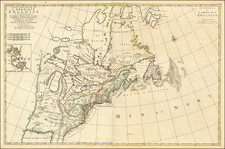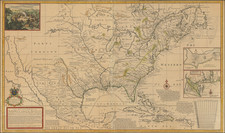Rare contemporary portrait of Sir Francis Drake, celebrating his circumnavigation of the World, engraved by Jodocus Hondius during his residency in London and later finished by George Vertue in the early 18th Century.
This marvelous engraving is generally considered the finest contemporary portrait of Sir Francis Drake. It has been attributed as the work of the engraver, Jodocus Hondius, since the 18th century, although Kraus and others suggest it might also be the work of Remigius Hogenberg. It may have been taken from a large portrait of Drake, which no longer survives.
As noted in Engraving in England in the Sixteenth & Seventeenth Centuries. . . . The first edition of the portrait is known to survive in only two examples. The present example is from the second state, published by George Vertue in the 18th century, from the original copper plate, which he altered by adding additional shading to the background.
The inscription added by Virtue at the bottom of the portrait shows that the view was engraved during Drake's life, and was made from a plate preserved by Drake's family. The full text reads reads:
Habes: Lector candide fortiss. ac invictiss. Ducis Draeck ad Vivum Imaginem qui toto terrarum orbe, duorum annorum, et mensium decem spatio, Zephyris faventibus,circumducto, Angliam sedes proprias 4. Ca. Octobr. anno a partu Virginis 1580 revist cum antea prtu. soluisset. Id. Decem annui. 1577.
A cornerstone for any Drake collection. Kraus used this portrait as the frontispiece for his book on Drake.
Jodocus Hondius the Elder (1563-1612), or Joost de Hondt, was one of the most prominent geographers and engravers of his time. His work did much to establish Amsterdam as the center of cartographic publishing in the seventeenth century. Born in Wakken but raised in Ghent, the young Jodocus worked as an engraver, instrument maker, and globe maker.
Hondius moved to London in 1584, fleeing religious persecution in Flanders. There, he worked for Richard Hakluyt and Edward Wright, among others. Hondius also engraved the globe gores for Emery Molyneux’s pair of globes in 1592; Wright plotted the coastlines. His engraving and nautical painting skills introduced him to an elite group of geographic knowledge seekers and producers, including the navigators Drake, Thomas Cavendish, and Walter Raleigh, as well as engravers like Theodor De Bry and Augustine Ryther. This network gave Hondius access to manuscript charts and descriptions which he then translated into engraved maps.
In 1593 Hondius returned to Amsterdam, where he lived for the rest of his life. Hondius worked in partnership with Cornelis Claesz, a publisher, and maintained his ties to contacts in Europe and England. For example, from 1605 to 1610, Hondius engraved the plates for John Speed’s Theatre of the Empire of Great Britaine.
One of Hondius’ most successful commercial ventures was the reprinting of Mercator’s atlas. When he acquired the Mercator plates, he added 36 maps, many engraved by him, and released the atlas under Mercator’s name, helping to solidify Mercator’s reputation posthumously. Hondius died in 1612, at only 48 years of age, after which time his son of the same name and another son, Henricus, took over the business, including the reissuing of the Mercator atlas. After 1633, Hondius the Elder’s son-in-law, Johannes Janssonius, was also listed as a co-publisher for the atlas.









![[ First Map to Name The United States ] L'Amerique septentrionale ou se remarquent les Etats Unis . . . 1779](https://storage.googleapis.com/raremaps/img/small/94192.jpg)


![(American Lithography) [Collection of Early American Lithographs, including the First Known American Lithograph of a Natural History Subject - by Charles Alexandre Lesueur; early lithographs by Abadie and other unnamed experimentalists; and unattributed student artwork, likely by pupils of Marie Duclos Fretageot's girl's school]](https://storage.googleapis.com/raremaps/img/small/90036.jpg)
![[ Rare Group of American Maps Published in Prague ] Neueste Länder und Völkerkunde. Ein geographisches Lesebuch für alle Stände . . . Funfzenter Band America Mit Charten . . . 1818](https://storage.googleapis.com/raremaps/img/small/102973.jpg)
![[ World Map Facsimile ] Typus Universalis Terrae, Iuxta Modernorum Distinctionem et Extensionem Per Regna et Provincias](https://storage.googleapis.com/raremaps/img/small/95596.jpg)